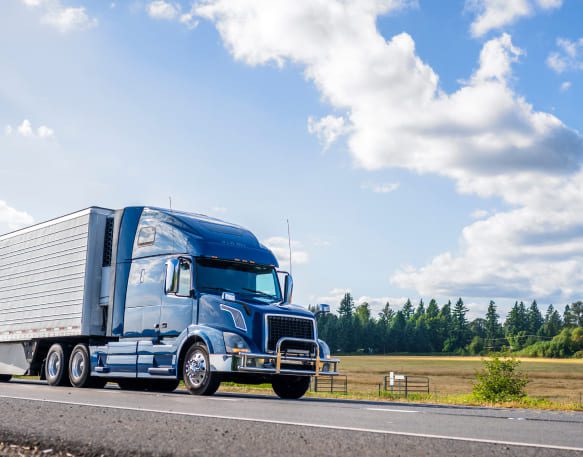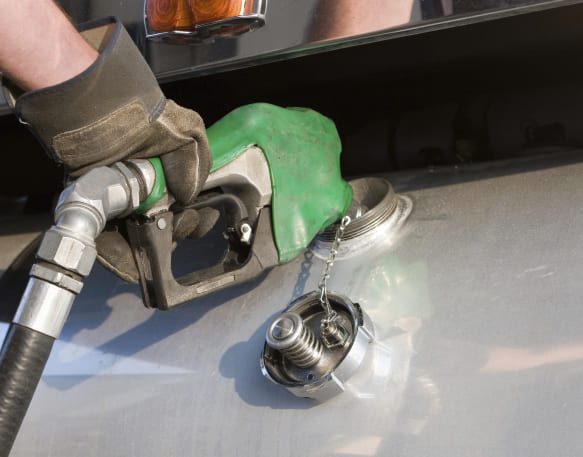Navigating semi-truck insurance: understanding coverage needs and legal requirements
Truckers are the lifeblood of the American economy, transporting more than 72% of the nation’s freight by weight. They navigate a demanding industry where every mile matters, ensuring that products reach destinations on time for use or sale. This responsibility makes it even more important to secure the right semi-truck insurance coverage.
Trucking insurance provides vital protection for your business, whether you operate a single delivery van or a multi-state fleet of semi-trucks. It’s often a state and federal legal requirement, and provides liability protection and financial security that protects goods while in transit. Trucking insurance also protects your drivers, vehicles, and corporate reputation—providing peace of mind despite any unforeseen challenges on the road.
Essential coverage for semi-trucks
Choosing coverage for a semi-truck is a strategic decision that helps your company respond to the many risks of the road. Before we explore how to determine your semi-truck insurance rate, let’s learn more about different types of coverage.
Here are the most common forms of semi-truck insurance to consider:
- Liability insurance: Policies that cover costs associated with physical injury and property damage. Liability insurance helps protect against financial loss from lawsuits or claims against your drivers.
- Physical damage insurance: Policies that cover costs associated with accidents, theft, vandalism, or natural disasters. Physical damage insurance typically covers repair or replacement costs through collision insurance (for vehicle damage) and comprehensive insurance (for non-collision damage).
- Cargo insurance: Policies that protect the value of your cargo against theft, damage, or other forms of loss. Cargo insurance protects the financial value of your cargo in transit, a barrier against financial loss and testament to brand reputation in the eyes of potential partners.
- Bobtail insurance: Policies that cover trucks operating without trailers. Bobtail insurance covers semi-trucks traveling to a pickup site, returning home after a delivery, or connecting with a trailer at another location.
- Occupational accident insurance: Policies that cover drivers who become injured while performing job-related duties. Occupational accident insurance covers drivers where workers’ compensation doesn’t, providing appropriate compensation in the unfortunate event of death, dismemberment, paralysis, disability, or a range of other medical expenses.
In the world of semi-truck operation, choosing one form of coverage doesn’t mean rejecting another. Depending on your company’s size, business nature, and driver workforce, you might need to purchase several forms of insurance to properly cover all operations.
Choosing the right form, or forms, of coverage for your semi-truck operations isn’t a simple task. The decision-making process requires knowledge about your drivers, semi-trucks, operating radius, and the type of cargo you transport.
Determining insurance rates for semi-trucks
There are a number of factors that determine your exact semi-truck insurance rates. For example, your company’s claims history, driver experience, and regulatory compliance records can all affect the exact amount you pay for coverage. Let’s delve into a few more important factors that affect semi-truck insurance rates.
Driving record
Carrier driving records will significantly influence semi-truck insurance rates. Safe driving habits will greatly help to drive down rates. Just as easily, traffic infractions or violations can make rates even more expensive.
Insurance providers assess the driving history of truck drivers to gauge their level of risk on the road. A clean driving record, one without accidents or citations, suggests responsible and safe driving behavior. This demonstrates to insurers that drivers are less likely to be involved in collisions, reducing the probability of insurance claims. Companies with these low-risk drivers are more likely to qualify for lower insurance premiums.
Conversely, a poor driving record indicates a higher risk of accidents and insurance claims. Insurance companies view higher-risk drivers may face elevated insurance premiums to offset the increased likelihood of these claims.
Vehicle value
Semi-truck insurance providers consider the make, model, year, and overall value of each vehicle when calculating insurance premiums. Newer trucks typically have higher values and may come equipped with advanced safety features, making them less susceptible to accidents and theft. On the other hand, older trucks or those with a lower market value may have higher insurance premiums, as they may be more prone to mechanical issues, breakdowns, or accidents.
Operating radius
Insurance companies also assess the geographic area in which a truck operates when determining rates. Your location will affect the likelihood of accidents, theft, and other potential hazards. Trucks that primarily operate within a smaller, local radius are generally perceived as lower risk compared to those that travel long distances or cross state lines. Local operations typically involve less time on the road, fewer miles driven, and a lower likelihood of encountering unfamiliar road conditions or congested traffic, further reducing the probability of accidents.
Semi-trucks that travel long distances or operate across multiple states are naturally exposed to more risks over longer periods of time. Driver fatigue, adverse weather conditions, and unfamiliar roadways can all make for more expensive insurance premiums. The extensive travel involved in long-haul operations also increases the likelihood of accidents, breakdowns, and other incidents—driving insurance rates higher.
Cargo type
The nature of your cargo can affect the likelihood of risks like theft, damage, even spoiled produce. This makes cargo type an important determining factor in your semi-truck insurance rate. Hauling hazardous materials or high-value goods, such as electronics or pharmaceuticals, poses a greater risk compared to transporting standard, non-hazardous assets. Adjusting insurance rates based on cargo type allows insurers to assess claims costs and provide coverage that meets your drivers’ needs.
Tailoring policies for semi-trucks
Your semi-truck insurance policy and premium should match your fleets’ size, operating radius, and other features of your business unique to you. Insurance providers also help you tailor policy features like deductibles, endorsements, and exclusions to create a personalized policy.
Here’s how semi-truck insurance companies can tailor a policy for your fleet:
- Deductibles: These are out-of-pocket expenses your trucking company must pay before insurance coverage kicks in. Higher deductibles can lower insurance premiums but may increase your financial burden in the event of a claim. Lower deductibles create higher premiums but provide more immediate financial protection in case of accidents or losses.
- Limits: The maximum amount your semi-truck insurance provider pays in response to a claim. Consider your probability and tolerance for risks like bodily injury, property damage, and cargo loss to determine your exact coverage limits.
- Endorsements: Amendments to your existing insurance contract that allow for additional coverage options on top of your existing policy.
- Exclusions: Amendments to your existing insurance contract that specify items not covered by your current policy.
Make sure to review your fleet’s needs and risk threshold before agreeing to, or amending, your policy. It’s also important to follow insurance shopping best practices when evaluating options, comparing quotes and evaluating policy terms before signing on the dotted line.
Smart insurance shopping tips for semi-trucks
Research is an irreplaceable step when navigating semi-truck insurance options. After all, insurance providers take their time in auditing your company before building a policy. It’s important that you do your homework on all potential insurance providers, learning how they build policies, respond to claims, and offer coverage to comparable companies.
Let’s dive into a few insurance shopping best practices, including quote comparison and policy term evaluation.
Compare quotes
Given the wide range of semi-truck insurance providers and policies out there, it’s important to obtain multiple quotes to assess coverage, premium rates, deductibles, and other policy features. This analysis empowers companies to make informed decisions based on the best options for you.
Comparing quotes can also provide your semi-truck company with the power to negotiate better terms and conditions. This can help you secure better coverage and foster a stronger, more personal relationship with your insurer of choice.
Assess agency reputations
The reputation of an insurance agency reflects its track record in handling claims and responding to customer needs. For semi-truck companies, partnering with a strong insurance agency is a confidence-boosting move. When challenges arise, businesses can know that claims will be processed efficiently and coverage will be honored when needed most.
Finding the best insurance provider also yields dividends once your policy begins. Insurance carriers with poor reputations may exhibit a history of delayed claim processing, inadequate customer support, or even financial insolvency. By thoroughly evaluating agency reputations, you can identify red flags and avoid potential risks that could jeopardize your own financial stability.
Grasp policy terms
Make sure you fully understand all aspects of your policy before signing. Insurance policies for commercial trucking can be complex documents filled with legal jargon and technical language. Taking the time to carefully review and understand your policy terms helps you avoid misunderstandings or unexpected gaps in coverage. Though tedious, reading through your policy’s terms helps your team accurately assess the scope of coverage, including liability limits, deductibles, exclusions, and additional endorsements.
Marquee Insurance Group: Your partner in reliable, affordable semi-truck coverage
If you’re in the market for semi-truck insurance, it’s important to find a provider that works as hard as you do. The trucking industry carries inherent risks, which means you need an insurance partner who understands those risks and the best ways to mitigate them. That partner—Marquee Insurance Group—has a strong track record of providing reliable insurance coverage to carriers like you.
Marquee Insurance Group was founded specifically to serve the trucking industry. Competitive rates, responsive service, and custom coverage options mean they understand the unique challenges you face in the trucking industry. Whether you need coverage for physical damage, bodily injury liability, or workers’ compensation, Marquee Insurance Group has you covered. They can also provide additional coverage specific to the type of cargo you transport.
Navigating claims for semi-trucks
In the event of an accident, theft, or other damage, it’s important that you know how to navigate the claims process. Effective claims handling helps to minimize operational disruptions and limit any financial loss.
Here are a few steps to follow in the claims process:
- Safety and documentation: Ensure that all drivers, passengers, and other participants in an accident or loss are physically safe. Document the scene of the incident with photographs, witness statements, and police reports if applicable.
- Notify your insurance provider: Follow your insurance company’s claims process by notifying them of the issue. Make sure to provide correct detailed information about the incident’s date, time, location, and circumstances. Include any issues affecting your drivers, cargo, or vehicles.
- Communicate: Keep communication channels open with your insurance carrier as they follow the claims process. They may ask you to clarify certain details of the incident or answer additional questions.
Make sure you have proactive risk management strategies in place before you need to file a claim. These features might include training programs that refresh drivers’ on-road knowledge. You can also implement trucking-specific AI technologies that monitor driver behavior and vehicle performance. These strategies allow you to collect additional information in the event of a claim, while helping reduce the likelihood of actual loss.
Finding the right semi-truck insurance provider
Partnering with the right insurance provider is an underrated step in semi-truck success. While a high-quality provider can help expedite claims and tailor plans to suit your needs, inadequate insurance providers may leave you waiting for support and offer only rigid plans that don’t allow for flexibility.
It’s also important to determine the individual features your plan might need before signing with a provider. This means learning more about your individual business needs—and more about provider packages—before purchasing any next steps. Depending on your location, vehicle type, cargo, and other factors, you can use policy addendums like endorsements and exclusions to get the right coverage for the right price.
Navigate the unexpected with DAT and Marquee Insurance Group
It’s impossible to forecast the challenges your fleet might find on the road. But partnering with Marquee Insurance Group through DAT allows your organization to navigate those challenges with confidence. Explore the cost-effective solutions and convenient coverage options your fleet deserves.




